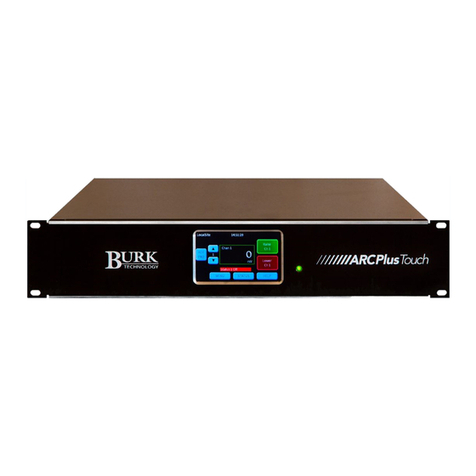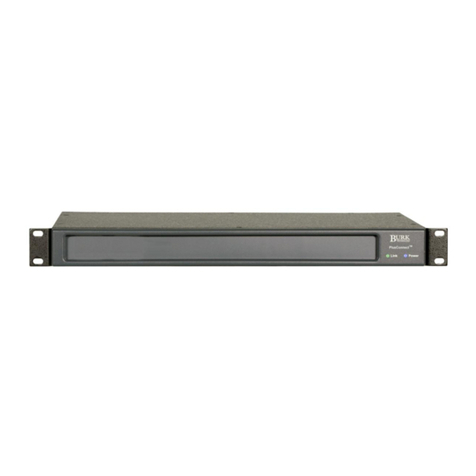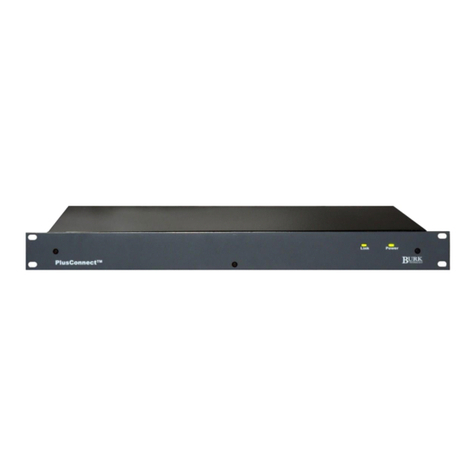5 CONNECTING SITE EQUIPMENT
Separate Command Relay and Wiring Interface units are used with the GSC3000 and VRC2500 to provide connections to
your site equipment using push-on blocks to simplify connections – no soldering is required.
Connecting a Wiring Interface
The Wiring Interface is used to connect your metering and status inputs. The allowable input range for status inputs is
±30VDC, and 0-10VDC or -5 to +5VDC for metering inputs (specified in metering configuration). For help configuring
metering and status inputs, or for help calibrating your metering inputs, see Chapter 4 of the GSC3000 & VRC2500
Installation & Operation Manual.
The GSC3000 and VRC2500 units will not tolerate a floating ground. If any of your inputs has a floating ground, use an isolation amplifier
before connecting it to the Wiring Interface.
TTooccoonnnneeccttmmeetteerriinnggaannddssttaattuussiinnppuuttss::
If you have two Wiring Interfaces, you must designate one for status and one for metering channels. For GSC3000 I/O 8
units only, the Wiring Interface will be used for both metering and status inputs.
Note: When using the Wiring Interface with an I/O 8, connect metering inputs to the channels on the Wiring Interface marked 1-8, and connect
Status to 9-16.
1. CCoonnnneeccttyyoouurrssiitteeeeqquuiippmmeennttto the provided two-pin push-on block connectors..Secure the wires with the built-in
setscrews. The status or metering sample connects to the ++terminal, and a common ground connects to the ––termi-
nal.
2. CCoonnnneecctttthheeppuusshh--oonnbblloocckkssto the Wiring Interface with the setscrews facing up..Be
sure to precisely align the connector terminals to the ++and ––contacts on the back
panel of the Wiring Interface. If you have already set up all your channel properties in
Unit Configuration (step 4), be sure to connect your equipment to the channels you
specified during unit configuration.
3. Use the provided DB37 cable to ccoonnnneecctttthheeSSIITTE
ECCOONNTTRROOLLLLEERRII//OOppoorrtton the Wiring Interface ttootthheeMMEETTEERRIINNGG
oorrSSTTAATTUUSSppoorrtt(depending on which inputs this Wiring Interface is used for) on the VRC2500 or GSC3000 I/O 16
unit, or the METERING/STATUS port on an I/O 8.
Connecting a Command Relay Unit
Each Command Relay has eight command output channels (each channel has an A and B relay). The I/O unit’s command
outputs are open collector, and can be momentary or latching. The allowable voltage range is 30VDC, 250mA maximum.
Power for the Command Relay is supplied by the I/O unit through the DB37 cable. The DC power connector on the left
side is
not
used with the GSC3000 and VRC2500. For help configuring command outputs, see Chapter 4 of the GSC3000
& VRC2500 Installation & Operation Manual.
TTooccoonnnneeccttoouuttppuuttcchhaannnneellss::
1. CCoonnnneeccttyyoouurrssiitteeeeqquuiippmmeennttto the provided three-terminal push-on block connectors..
Secure the wires with the built-in setscrews. Connections are standard Form C, from left
to right: normally open (NO), normally closed (NC) and common (C).
2. CCoonnnneecctttthheeppuusshh--oonnbblloocckkssto the rear panel of the command relay with the setscrews facing up..Use care to proper-
ly align each terminal with the contacts on the back panel of the Command Relay unit. If you set up all your channel
properties (labels, limits, alarms, etc.) in Lynx before installing the Command Relay, be sure to connect your equip-
ment to the channels you specified during unit configuration.
3. Use the provided DB37 cable to c
coonnnneecctttthheeDDBB3377ppoorrtton the Command Relay ttooCCOOMMMMAANNDD11--88oorrCCOOMMMMAANNDD
99--1166on the VRC2500 or GSC3000 I/O unit.
4 UNIT CONFIGURATION
You must configure your GSC3000 I/O and Voice
Interface, and VRC2500 units before you will be
able to use them to control and monitor your site
equipment.
TTooccoonnffiigguurreeII//OOaannddVVooiicceeIInntteerrffaacceeUUnniittss::
1. SSeelleeccttyyoouurrssiitteein the Site List and use the
expand button to view all connected units in your
site. A unit icon will appear for every I/O and
Voice Interface unit in the system.
Refer to Chapter 2 of the GSC3000 & VRC2500
Installation & Operation Manual for instructions
on adding I/O and Voice Interface units to an
existing GSC3000 site. Site capacity for the
VRC2500 is not expandable and consists of one
I/O and one Voice Interface unit.
2. SSeelleecctttthheeuunniittyyoouuwwiisshhttooccoonnffiigguurreeand
cclliicckktthheeUUnniittCCoonnffiigguurraattiioonniiccoonnin the
toolbar. This will open the Unit Configuration
Window. Only one unit can be configured at
a time.
3. Use the tabs at
the top to switch
between the dif-
ferent configura-
tion options. To
set up your
metering input
and status input
channels, select
the MMeetteerriinnggand
SSttaattuusstabs. For command outputs, select the
CCoommmmaannddsstab.
You can configure your unit at any time and do
not need to set up each option before proceed-
ing to the next section.
For detailed descriptions of each configuration
option, please refer to Chapter 4 in the GSC3000
& VRC2500 Installation & Operation Manual.
4. Once you have set up your unit, click the SSaavveettoo
UUnniitticon to upload these settings to the
unit. You can also create an archive to save a
local copy of your configuration, which you can
edit off-line, by clicking on the SSaavveettooAArrcchhiivvee
icon .
5. If at this time you wish to configure each remain-
ing I/O and Voice Interface units at your site,
repeat steps 1-5. Remember you will be able to
configure these units later.
DOC42A004 REV A 11/07
6 REMOTE CONNECTIONS
In addition to accessing your site with a direct PC
connection, you can connect remotely using a
dial-up or full-time modem, or a PC on the same
LAN/WAN as the computer with the modem con-
nection. For direct LAN/WAN access, you can use
GSC/VRC Web Interface for your remote connec-
tion. Please refer to Chapter 6 in the Installation
and Operation Manual for instructions on making
modem connections.
Dial-Up Connection
To establish a dial-up connection to remotely
access your site in Lynx, an external dial-up
modem is needed at the GSC3000 or VRC2500
site. Instructions for connecting a dial-up modem
vary depending on whether it is being connected
to a GSC3000 I/O Unit, Voice Interface, or
VRC2500.
Full-Time Connection
A full-time (two- or four-wire) connection is a
dedicated audio communication link which does
not require dialing. This includes leased lines, RF
link, or an audio STL/TSL. To establish a full-time
connection to your site, a specialized external
modem is needed at both the PC and remote
site.
Digital communication links which support RS-
232 do not need to use full-time modems to
communicate with the site. Digital RS-232 links
interface directly to the GSC3000 I/O or
VRC2500.
TCP/IP (Site Sharing)
When one computer on the LAN/WAN has a
modem connection to the remote site, other
computers can share that connection using
TCP/IP. This is called Site Sharing, and is set up
in the Site Wizard when you create the site in
Lynx. See Chapter 2 in the Manual.
Web Interface
Burk Technology offers the GSC/VRC Web
Interface so that you can establish a direct
TCP/IP connection to your remote site. The Web
Interface also provides access from a Web brows-
er. For more information on the Web Interface,
Interface Instruction Manual for the physical con-
nections.






















